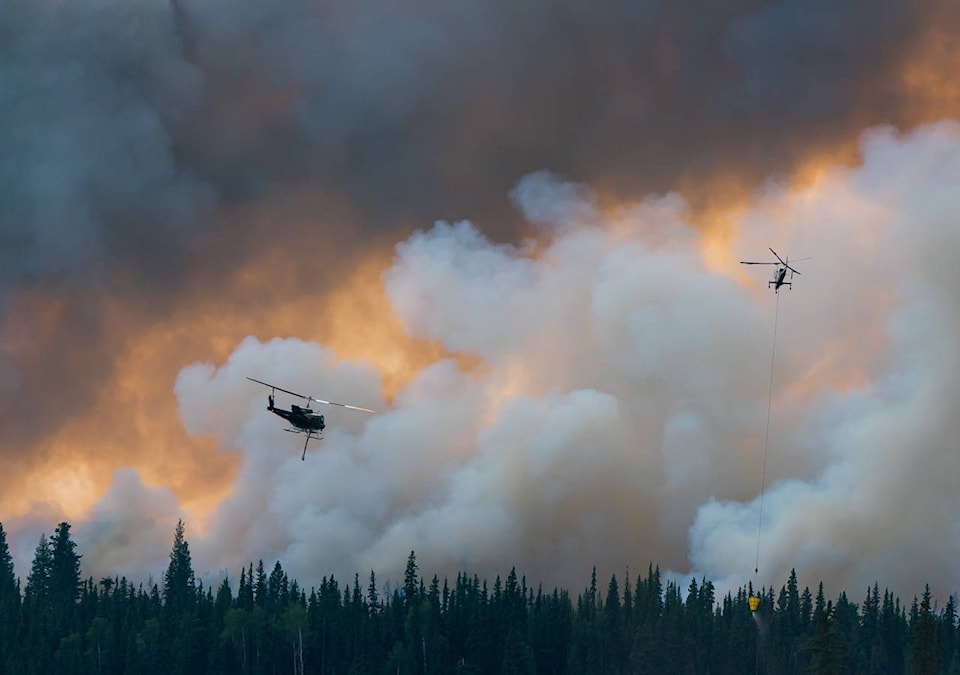More than 1,000 properties in the South Cariboo on evacuation order since July 14 were downgraded to alert late last week, as BC Wildfire Crews continued to make progress in the fight against several fires of note in the region.
The Cariboo Regional District announced Saturday afternoon that residents of 482 properties in the South Canim Lake and Mahood Lake region could return home after being evacuated for 11 days. The same news was delivered to 664 properties in the Flat Lake to Green Lake North order area, including portions of the western edge of Lone Butte.
As of press time Wednesday morning, an evacuation order was still in place for properties just south of 83 Mile and north to around 94 Mile, on both sides of Highway 97, due to the nearby Flat Lake fire.
Residents in North Green Lake, Horse Lake, Lone Butte, Sheridan Lake and the District of 100 Mile House remain under evacuation alert, along with those at the south and north ends of Canim Lake, including Eagle Creek and most of Forest Grove.
While precipitation over the past week was minimal in the region, cooler temperatures did play a part in helping crews to get a handle on the fires, BC Wildfire Service officials said.
“With cooler temperatures and increased humidity, the fuels are damper and not as susceptible to ignition or combustion,” BCWS information officer Roslyn Johnson said. “With the decreased fire behaviour, it gives us a chance to put the crews right on the edge of the fire.”
READ MORE: Planned ignitions at Flat Lake fire called off due to wind
The Flat Lake fire, discovered on July 8 about 27 kilometres southwest of 100 Mile House, remains the largest fire of note in the South Cariboo. It was most recently measured at 39,584 hectares and is classified as “out of control.”
Aerial ignitions have been taking place when conditions allow, in an effort to remove unburned fuel between the fire perimeter and the control lines.
“Planned ignitions are an essential and effective tactic that the BC Wildfire Service uses to help contain very large fires,” an update posted to the BCWS website Tuesday said. “This tactic will bring the fire’s edge to more easily accessible locations where ground crews can safely deliver water directly to the fire’s edge.”
The wildfire at Young Lake, about 35 kilometres southeast of 70 Mile, grew significantly over the past week and is now estimated to be 4,000 hectares.
Late in the week, crews faced challenges with erratic winds which interfered with plans to carry out aerial ignitions. However, with better conditions on Sunday and Monday, planned burns along the northeastern flank were conducted successfully in an effort to secure the containment line.
An evacuation order issued by the Thompson-Nicola Regional District for 103 properties in Electoral Area E (Bonaparte Plateau) remains in place due to the Young Lake fire.
The Canim Lake fire remains active at 2,673 hectares in size with containment lines around the north and west sides, with crews continuing to patrol that area. A contingency guard has been established on the south flank and crews are working on a guard on the east side, south of MacNeil Lake.
The 454-hectare fire north of Chasm has a fuel-free guard set up around its perimeter, with crews working to patrol and extinguish hot spots in the area.
Wildfire officials are reminding property owners whose evacuation orders were downgraded last week to stay prepared for changing fire conditions. With the temperatures rising this week, Johnson said crews are bracing themselves for more challenging conditions.
“The relative humidity, or the amount of moisture in the air, will decrease down to the mid-teens,” Johnson said. “That will likely mean increased fire behaviour because the fuels are more susceptible.”
patrick.davies@100milefreepress.net
Like us on Facebook and follow us on Twitter.
